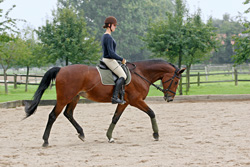No two horses are the same. The individual difference lie in “outside” characteristics (conformation, breed, gender) and in character types– what’s “inside.” The following character overview is by no means all-encompassing, but rather broadly covers major points. I hope that readers will be able to recognize some of their horse’s traits within the generalized categories in this section.
The Overachiever
This type of horse is characterized by his enormous work ethic and a high degree of ambition, which is sometimes falsely interpreted as nervousness. The overachiever wants to learn and to please. He frequently anticipates, meaning that he acts ahead of his rider’s aids, and therefore makes mistakes. It can be difficult to get this type of horse to relax, often due to the rider’s inappropriate reaction to her horse’s anticipation.

The owner of an overachieving horse should count herself lucky. She must only learn to steer her horse’s ambition so that the horse doesn’t “get in his own way.” When this is achieved, working with this type of horse is a pleasure.
Common training mistakes: It is fundamentally wrong to punish the horse for mistakes that result from his eagerness to learn and to perform. In addition, frequent repetitions of the same exercises should be avoided.
Training tips: So, you have an overachiever? Congratulations! As previously stated, it is not the overeagerness of the horse that causes problems, but the way in which the rider reacts to his eagerness. If you can learn to keep this type of horse happy, you can teach him anything. In the dressage ring, it is the overachieving horse that is said to be “electric,” meaning he reacts immediately to subtle aids, is sensitive to the leg, has a healthy desire to go forward, and is willing to learn. It is also this type of horse–assuming he has good jumping ability–that can complete a technically difficult course better than others.
Once rhythm, suppleness and relaxation, and contact have been achieved (or even, more simply, just “gas, brakes, and steering”), it is a good idea to teach this type of horse simple dressage movements in order to utilize his mental capacity and keep him from getting bored.
Note that it is important not to endlessly repeat the same exercise. The best example in the lower level range is the simple change of lead. While a rider of a slow, stolid horse can repeat this exercise 10 times in a row, an overachiever should only be asked two to three times in succession. Once he realizes what is coming next, he no longer waits for the rider’s aids–he anticipates. This will only make the simple change worse: the horse will likely jig rather than walk in between canter leads and he will become tense. The more the rider tries to practice the now-not-so-good simple change in order to improve it, the more stressed the horse will become, since he now feels the rider is holding him back-he understands he is supposed to pick up the new canter lead, but he doesn’t “get” that he is supposed to execute pure walk steps in between departs. When the rider continues to practice the movement and perhaps now punishes the horse for “misbehaving,” the horse becomes even more tense and exasperated. This vicious cycle takes the joy out of the work for this naturally willing animal.
Instead of repetition, the rider should make a point of adding variety within a movement. Ride two simple changes, then ask for something completely different, and then eventually ask for one or two more simple changes. If the horse still doesn’t wait for the rider’s aids and execute a correct simple change of lead with clear walk steps in between, then the rider must increase the number of walk steps for training purposes. Instead of requiring three to four steps, the rider can have the horse walk for 10 or more. Or, she can ask for a leg yield or shoulder-in (for more advanced horses) at the walk, which helps prevent the horse from predicting what comes next. The horse must wait for the rider’s aids-exactly what he is supposed to learn–and while waiting, he relaxes. As you now know, relaxation is a prerequisite for successfully performing any movement.
The Sensitive Horse
For the right rider, this type of horse can be a true gift. Sensitive horses usually have a healthy degree of forwardness, react well to light and subtle aids, and are usually obedient in a concerted effort to do everything right.
That is one side of the coin. On the other side they are quick to take offense at anything and everything they don’t understand. This could be an incorrect aid, or simply one that was given too strongly or not clearly enough. Asking for a movement in the wrong place, such as a flying change too deep in the corner or a rein-back too close to the arena wall or fence, can upset a sensitive horse. As can minor equipment problems, such as a poorly fastened noseband. While many horses would not let such things ruin their composure, a sensitive horse definitely will. Therefore, this type of horse is only suitable for an experienced, skilled rider with a good amount of “feel.”
Common training mistakes: It is a mistake for a rider with limited ability to ride a sensitive horse. Such a combination frequently ends in disaster, since this type of horse becomes easily insecure and frustrated by inappropriate aids or poor riding. Anger and punishment is inappropriate in the training of a sensitive horse.
Training tips: Sensitive horses are best compared with artists or perhaps even geniuses. Their sensitivity is their strength and also their weakness. They can achieve great things but can also be inordinately upset by something miniscule and therefore stand in their own way.
The rider of a sensitive horse should see this character type as a gift and try to maintain the horse’s sensitivity, including accommodating the horse’s quirks. When the rider knows his horse well he will know what causes him stress and should deal with related situations gracefully, without becoming frustrated and angry. When a sensitive horse is trained in accordance with the Training Scale, his sensitivity is put to good use, allowing him to come “on the aids” and attain “throughness.” This type of horse will react to the most subtle of aids and the rider need expend little energy to ride him. When training problems (inevitably) occur along the way, the rider must be careful not to go overboard and use too much whip or spur, or to push the horse too fast. The sensitive horse reacts very negatively to harsh punishment or being pushed before he is ready, and such things can affect the horse’s willingness to work in the future.
Read about four other character types–The Hyper or Overreactive Horse, The Slow or Stolid Horse, The Hot Horse and The Prankster–in the May 2010 issue of Practical Horseman magazine. To buy Dressage Training – Customized, visit HorseBooksEtc.com.










